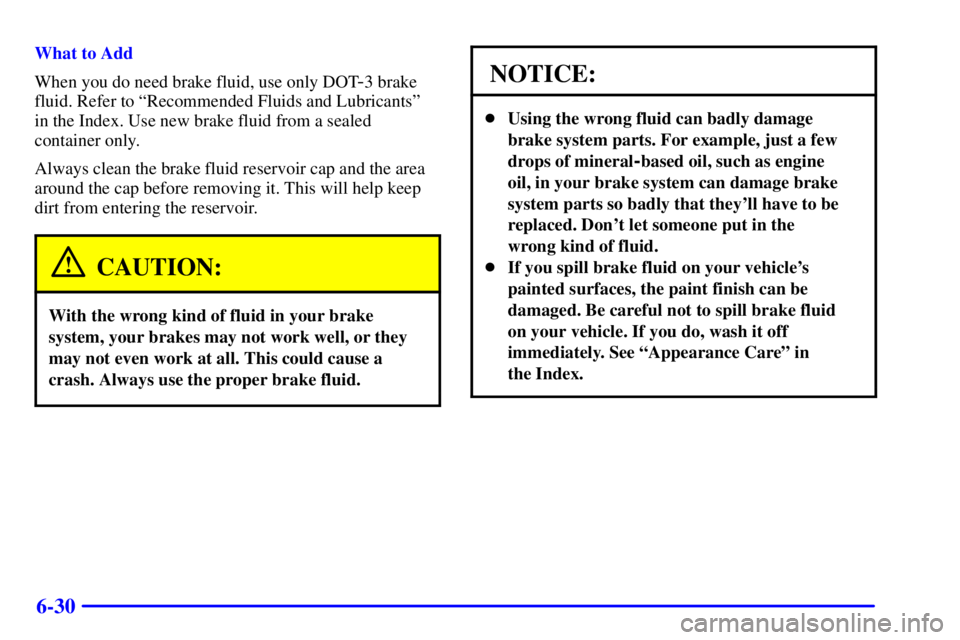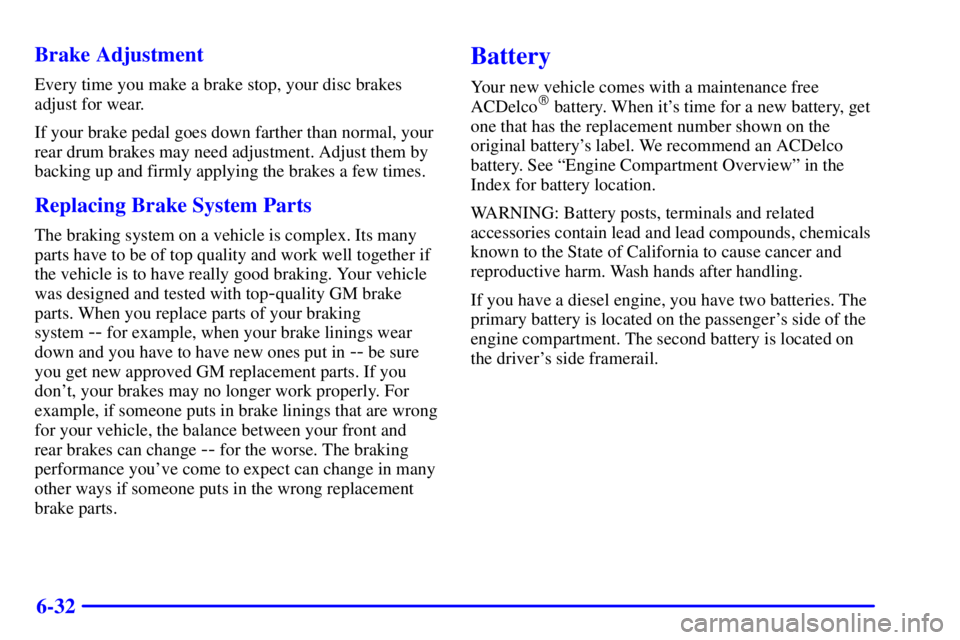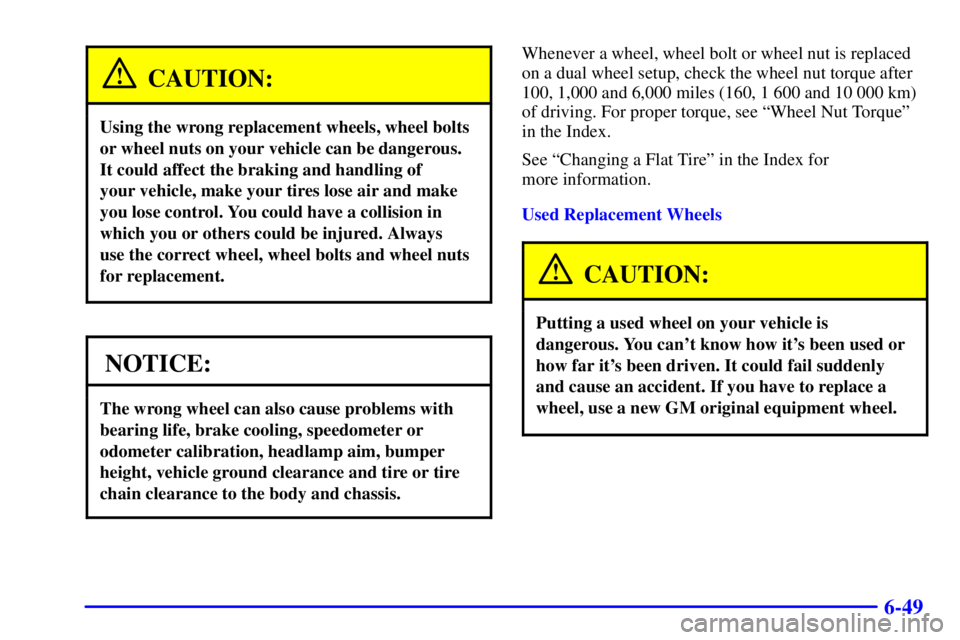Page 299 of 412

6-30
What to Add
When you do need brake fluid, use only DOT
-3 brake
fluid. Refer to ªRecommended Fluids and Lubricantsº
in the Index. Use new brake fluid from a sealed
container only.
Always clean the brake fluid reservoir cap and the area
around the cap before removing it. This will help keep
dirt from entering the reservoir.
CAUTION:
With the wrong kind of fluid in your brake
system, your brakes may not work well, or they
may not even work at all. This could cause a
crash. Always use the proper brake fluid.
NOTICE:
�Using the wrong fluid can badly damage
brake system parts. For example, just a few
drops of mineral
-based oil, such as engine
oil, in your brake system can damage brake
system parts so badly that they'll have to be
replaced. Don't let someone put in the
wrong kind of fluid.
�If you spill brake fluid on your vehicle's
painted surfaces, the paint finish can be
damaged. Be careful not to spill brake fluid
on your vehicle. If you do, wash it off
immediately. See ªAppearance Careº in
the Index.
Page 300 of 412

6-31 Brake Wear
Your vehicle has front disc brakes and rear drum brakes.
Disc brake pads have built
-in wear indicators that make a
high
-pitched warning sound when the brake pads are worn
and new pads are needed. The sound may come and go or
be heard all the time your vehicle is moving (except when
you are pushing on the brake pedal firmly).
CAUTION:
The brake wear warning sound means that soon
your brakes won't work well. That could lead to
an accident. When you hear the brake wear
warning sound, have your vehicle serviced.
NOTICE:
Continuing to drive with worn-out brake pads
could result in costly brake repair.
Some driving conditions or climates may cause a brake
squeal when the brakes are first applied or lightly
applied. This does not mean something is wrong with
your brakes.
Properly torqued wheel nuts are necessary to help
prevent brake pulsation. When tires are rotated, inspect
brake pads for wear and evenly tighten wheel nuts in the
proper sequence to GM torque specifications.
Your rear drum brakes don't have wear indicators, but if
you ever hear a rear brake rubbing noise, have the rear
brake linings inspected immediately. Also, the rear
brake drums should be removed and inspected each time
the tires are removed for rotation or changing. When
you have the front brake pads replaced, have the rear
brakes inspected, too.
Brake linings should always be replaced as complete
axle sets.
See ªBrake System Inspectionº in Section 7
of this manual under Part C ªPeriodic
Maintenance Inspections.º
Brake Pedal Travel
See your dealer if the brake pedal does not return to
normal height, or if there is a rapid increase in pedal
travel. This could be a sign of brake trouble.
Page 301 of 412

6-32 Brake Adjustment
Every time you make a brake stop, your disc brakes
adjust for wear.
If your brake pedal goes down farther than normal, your
rear drum brakes may need adjustment. Adjust them by
backing up and firmly applying the brakes a few times.
Replacing Brake System Parts
The braking system on a vehicle is complex. Its many
parts have to be of top quality and work well together if
the vehicle is to have really good braking. Your vehicle
was designed and tested with top
-quality GM brake
parts. When you replace parts of your braking
system
-- for example, when your brake linings wear
down and you have to have new ones put in
-- be sure
you get new approved GM replacement parts. If you
don't, your brakes may no longer work properly. For
example, if someone puts in brake linings that are wrong
for your vehicle, the balance between your front and
rear brakes can change
-- for the worse. The braking
performance you've come to expect can change in many
other ways if someone puts in the wrong replacement
brake parts.
Battery
Your new vehicle comes with a maintenance free
ACDelco� battery. When it's time for a new battery, get
one that has the replacement number shown on the
original battery's label. We recommend an ACDelco
battery. See ªEngine Compartment Overviewº in the
Index for battery location.
WARNING: Battery posts, terminals and related
accessories contain lead and lead compounds, chemicals
known to the State of California to cause cancer and
reproductive harm. Wash hands after handling.
If you have a diesel engine, you have two batteries. The
primary battery is located on the passenger's side of the
engine compartment. The second battery is located on
the driver's side framerail.
Page 318 of 412

6-49
CAUTION:
Using the wrong replacement wheels, wheel bolts
or wheel nuts on your vehicle can be dangerous.
It could affect the braking and handling of
your vehicle, make your tires lose air and make
you lose control. You could have a collision in
which you or others could be injured. Always
use the correct wheel, wheel bolts and wheel nuts
for replacement.
NOTICE:
The wrong wheel can also cause problems with
bearing life, brake cooling, speedometer or
odometer calibration, headlamp aim, bumper
height, vehicle ground clearance and tire or tire
chain clearance to the body and chassis.
Whenever a wheel, wheel bolt or wheel nut is replaced
on a dual wheel setup, check the wheel nut torque after
100, 1,000 and 6,000 miles (160, 1 600 and 10 000 km)
of driving. For proper torque, see ªWheel Nut Torqueº
in the Index.
See ªChanging a Flat Tireº in the Index for
more information.
Used Replacement Wheels
CAUTION:
Putting a used wheel on your vehicle is
dangerous. You can't know how it's been used or
how far it's been driven. It could fail suddenly
and cause an accident. If you have to replace a
wheel, use a new GM original equipment wheel.
Page 332 of 412
6-63
POSITION NAME CIRCUITS PROTECTED
15. DRL DRL Relay
16. TURN B/U
Front Turn, RR Turn, Back
-up Lamps, BTSI Solenoid
17.
RADIO
-1Radio (Ign, Accy), Upfitter Provision Relay
18. BRAKE 4WAL PCM, ABS, Cruise Control
19.
RADIO
-BRadio (Battery), Power Antenna
20. TRANS PRNDL, Automatic Transmission
21. SECURITY Passlock
22. RR DEFOG Rear Window Defog
23. NOT USED Not Used
24. RR HVAC RR HVAC Controls, HIGH, MED, LOW Relays
A. PWR ACCY
Power Door Lock, Six
-Way Power Seat, Keyless Entry
Illumination Module
B. PWR WDO Power Windows
Page 333 of 412
6-64 Engine Compartment Fuse Relay Center
The fuse block is on the driver's side of the engine
compartment at the rear.
NAME CIRCUITS PROTECTED
SPARE Spare Fuse
A.I.R. Air Pump
BLOWER Front Blower Motor
ABS Electronic Brake Control Module
IGN B Ignition Switch
IGN A Starter Relay, Ignition Switch
BATT Instrument Panel Fuse Block
LIGHTING Instrument Panel Fuse Block,
Headlamp Switch
RH
-HDLP Right-hand Headlamp
(Export only)
LH
-HDLP Left-hand Headlamp
(Export only)
RH
-HIBM Right-hand High-beam Headlamp
(Export only)
LH
-HIBM Left-hand High-beam Headlamp
(Export only)
Page 344 of 412

Scheduled Maintenance
7-5
Short Trip/City Definition
Follow the Short Trip/City Scheduled Maintenance if
any one of these conditions is true for your vehicle:
�Most trips are less than 5 to 10 miles (8 to 16 km).
This is particularly important when outside
temperatures are below freezing.
�Most trips include extensive idling (such as frequent
driving in stop
-and-go traffic).
�Most trips are through dusty areas.
�You frequently tow a trailer or use a carrier on top of
your vehicle.
�If the vehicle is used for delivery service, police, taxi
or other commercial application.
One of the reasons you should follow this schedule
if you operate your vehicle under any of these
conditions is that these conditions cause engine oil to
break down sooner.
Short Trip/City Intervals
Every 3,000 Miles (5 000 km): Engine Oil and
Filter Change (or 3 months, whichever occurs first).
Chassis Lubrication (or 3 months, whichever occurs
first). Drive Axle Service (or 3 months, whichever
occurs first).
Every 6,000 Miles (10 000 km): Tire Rotation.
Every 15,000 Miles (25 000 km): Diesel Engine Only:
Engine Air Cleaner Filter Inspection, if driving in
dusty conditions. Gasoline Engine Only: Noise
Shields Inspection (GVWR above 10,000 lbs. only).
Diesel Engine Only: Shields and Underhood
Insulation Inspection. Diesel Engine Only:
Thermostatically Controlled Engine Cooling Fan
Check (or every 12 months, whichever occurs first).
Diesel Engine Only: Air Intake System Inspection.
Front Wheel Bearing Repack (or at each brake
relining, whichever occurs first).
Page 346 of 412

Scheduled Maintenance
7-7
Long Trip/Highway Definition
Follow this scheduled maintenance only if none of the
conditions from the Short Trip/City Scheduled
Maintenance are true. Do not use this schedule if the
vehicle is used for trailer towing, driven in a dusty area
or used off paved roads. Use the Short Trip/City
schedule for these conditions.
Driving a vehicle with a fully warmed engine
under highway conditions causes engine oil to
break down slower.
Long Trip/Highway Intervals
Every 7,500 Miles (12 500 km): Engine Oil and Filter
Change (or every 12 months, whichever occurs first).
Chassis Lubrication (or every 12 months, whichever
occurs first). Drive Axle Service. Tire Rotation.
Every 15,000 Miles (25 000 km): Gasoline Engine
Only: Noise Shields Inspection (GVWR above
10,000 lbs. only). Diesel Engine Only: Shields and
Underhood Insulation Inspection. Diesel Engine
Only: Thermostatically Controlled Engine
Cooling Fan Check (or every 12 months, whichever
occurs first). Diesel Engine Only: Air Intake
System Inspection.
Every 30,000 Miles (50 000 km): Fuel Filter
Replacement. Diesel Engine Only: Engine Air
Cleaner Filter Replacement. Front Wheel
Bearing Repack (or at each brake relining,
whichever occurs first).